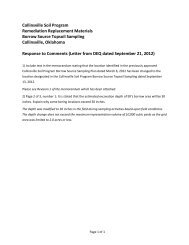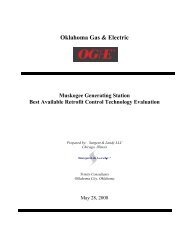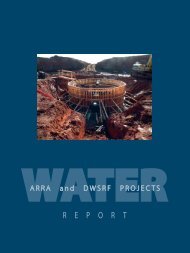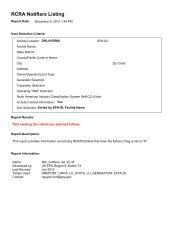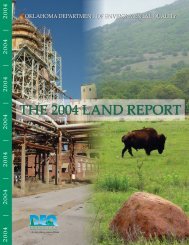Technical documentation and software quality assurance for project ...
Technical documentation and software quality assurance for project ...
Technical documentation and software quality assurance for project ...
You also want an ePaper? Increase the reach of your titles
YUMPU automatically turns print PDFs into web optimized ePapers that Google loves.
BLEVE<br />
Parameters that were varied were mass, humidity, emissive power, fraction flashed <strong>and</strong><br />
tank temperature. Comparisons were made on burn time, BLEVE diameter <strong>and</strong> the<br />
distance to the 5kQ/sq. m level of concern (LOC). No differences were found, outside of<br />
roundoff error, <strong>for</strong> the alternative language code model or ALOHA <strong>for</strong> burn time or<br />
BLEVE diameter. A slight difference (2%) in the LOC distance predictions was found<br />
between two model approaches, traceable to different numerical techniques <strong>for</strong> rootsolving<br />
of the equations.<br />
Pool Fire<br />
Parameters that were varied included wind speed <strong>and</strong> boiling point of the chemical. The<br />
latter was varied so as to cover both non-cryogenic <strong>and</strong> cryogenic liquids. Comparisons<br />
were made on the burn duration, flame length, flame tilt angle, <strong>and</strong> average emissive<br />
power. No differences were found, outside of roundoff error, between the alternative<br />
language code model <strong>and</strong> ALOHA. Results were also checked <strong>for</strong> the burn rate<br />
correlation <strong>for</strong>mula against experimentally reported values. A difference of 16% was<br />
found <strong>for</strong> the non-cryogenic case <strong>and</strong> 32% <strong>for</strong> the cryogenic case. It should be noted that<br />
the selected cryogenic example (butane) had the largest reported variance from the<br />
correlation <strong>for</strong>mula. Nevertheless, burn regression rate represents an area of uncertainty<br />
in the model.<br />
Flare<br />
Parameters that were varied were tank pressure (assuring both choked <strong>and</strong> unchoked<br />
flow) <strong>and</strong> wind speed. Comparisons were made on gas exit speed, effective source<br />
diameter, flame length <strong>and</strong> width, <strong>and</strong> flame tilt. No significant differences were found<br />
between ALOHA <strong>and</strong> the alternative language model.<br />
Vapor Cloud Explosion<br />
Overpressures 100 m downwind <strong>and</strong> 50 m. perpendicular to the wind <strong>for</strong> a 1000 kg<br />
instantaneous release <strong>and</strong> immediate ignition were compared <strong>for</strong> ALOHA <strong>and</strong> the<br />
alternative-coded model. Parameters that were varied were reactivity <strong>and</strong> level of<br />
congestion. Also the separate situation of immediate detonation by hard ignition was<br />
considered. Overpressure results in all cases showed no differences to four significant<br />
figures.<br />
(2) Comparison against existing models.<br />
ALOHA predictions were compared against existing fire <strong>and</strong> explosive prediction<br />
models. The models used were Automated Resource <strong>for</strong> Chemical Hazard Incident<br />
Evaluation (ARCHIE), produced by Hazmat America <strong>for</strong> the EPA, Risk Management<br />
Program Guidance <strong>for</strong> Offsite Consequence Analysis (RMP*Comp), produced by <strong>for</strong> the<br />
EPA Chemical Emergency Preparedness <strong>and</strong> Prevention Office, <strong>and</strong> the Maritime<br />
31



